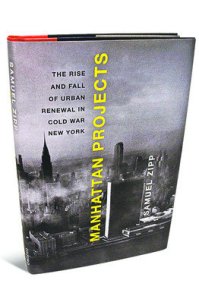 New Yorkers, when asked about their hometown, will rarely resort to a description of the place. Whether the resident in question is a cabbie or Jay-Z, the reply is far likelier to be an idea, a vision of possibility and of promise—or of decay and of dreams deferred—sometimes both at once. These visions reflect the cityscape and shape it, helping New Yorkers make sense of their city and also compelling them to remake it.
New Yorkers, when asked about their hometown, will rarely resort to a description of the place. Whether the resident in question is a cabbie or Jay-Z, the reply is far likelier to be an idea, a vision of possibility and of promise—or of decay and of dreams deferred—sometimes both at once. These visions reflect the cityscape and shape it, helping New Yorkers make sense of their city and also compelling them to remake it.
In his new book, Manhattan Projects: The Rise and Fall of Urban Renewal in Cold War New York, Samuel Zipp, an assistant professor of urban studies at Brown, explores the competing visions of the city that arose in the two decades following World War II. Charting the rise of four major sites of clearance and construction, Mr. Zipp argues that these projects must be understood as products of Cold War battles for cultural superiority, as well as of local developments.
At each stop along the way—the United Nations Headquarters, Stuyvesant Town, Lincoln Square and East Harlem—we encounter government planners, business and real estate interests, liberal reformers and local residents, all struggling to articulate their own ideas of what the postwar “Capital of the World” should be, fighting for “the right to give imaginative shape to the city.” The resulting account breathes new life into the ink-stained history of urban renewal and asks important questions about its legacy in today’s global metropolis.
Urban renewal, that most loaded of terms, is at the center of Mr. Zipp’s account of the intersection of meaning and material conditions in New York. The recent rehabilitation of Robert Moses notwithstanding, “urban renewal” continues to conjure up the worst misadventures of postwar planning: bleak tower blocks littered with junkies while clogged interstates screech in their midst. It is damned from the left as “negro removal,” the triumph of business and bureaucracy over the people, and from the right as socialism’s bitter fruit.
And yet, New Yorkers today not only enjoy the fruits of urban renewal—concerts at Lincoln Center, strolls along the Brooklyn Heights Promenade, apartments—but continue to renew their city—Atlantic Yards, save for its ZIP code, would be right at home in Manhattan Projects—even as they curse the phrase. It is this tension, between ideas and practice, between a modern desire to sweep away the old and nostalgia, that Mr. Zipp seeks to illuminate.
From the start, in prose that balances academic rigor and storytelling, he freely offers a revision: Mr. Zipp will call these projects “benevolent interventions,” in the spirit in which they were originally intended. To an audience steeped in grim and grisly tales of the Moses “meat axe,” the notion raises eyebrows, but Mr. Zipp makes his case with a compelling re-creation of the postwar historical moment.
After World War II, fresh from a victory that was made possible by “unprecedented planning at all levels of society,” New Yorkers returned home to a city that had become the de facto center of the free world in the wake of Europe’s destruction, but whose landscape remained dominated by vast swaths of depressed tenements. With the aid of 76 well-chosen plates to remind us that the visual vocabulary of poverty once centered on the low-rise, overcrowded “slum,” Mr. Zipp documents the rise of a liberal consensus bent on renewing the city. This coalition of diverse interests—elected politicians, city planners, private real estate developers, social reformers and tenant’s rights activists—sought to fulfill the expectation of postwar affluence in the same way they had the won the war, through the union of private and public interests. The unity of this coalition, and the power of their message, was further enhanced by the nascent Cold War, as the vision articulated by New York’s renewers sought to surpass the grand centralization of the Soviets, and “renovate the city in line with the metropolis’s mythic postwar image of itself.”
AND WHAT AN image! The building of the United Nations offers the ideal starting point to this tale, a renewal project that cleared but six fetid blocks of slaughterhouses and less than 200 families to erect a gleaming monument that confirmed New York as the center of the world. Whether from E.B. White, Robert Moses, or any number of state and local politicians, the rhetoric flowed freely, celebrating the “great world city,” “mighty and unparalleled.” This lofty language was not reserved for the world’s parliament, but was employed wherever buildings needed to come down so that great works of man might rise. Stuyvesant Town was a “Masterpiece of Capital,” a bastion of “wholesomeness” that would give rental preference to returning veterans, while Lincoln Center was ” a symbol of our cultural maturity” and the “noblest expression” of urban renewal. This language both compelled and captivated, urging even those who lost their homes to embrace the tide of bountiful modernity that was washing over the city.
As the problems of urban renewal became increasingly difficult to ignore, the liberal coalition began to fragment, but the discourse of triumphant American modernity remained pervasive, allowing those who remained invested in urban renewal (primarily the city and real estate developers) to press forward. Early resistors found themselves in an uphill battle to even command an audience, much less defeat the projects that threatened their homes and businesses.
Mr. Zipp argues that the tide began to turn against urban renewal only when the displaced began not just to protest their own loss, but to re-frame their position as the truly American vision of the city, in contrast to planners’ “totalitarian” excesses. While local activists were unable to prevent the razing of Lincoln Square, their question—”aren’t our homes beauty and culture?”—presaged successful arguments for preservation that found their apogee in Jane Jacobs’ 1961 masterpiece, The Death and Life of Great American Cities, and that, Mr. Zipp contends, ultimately brought down the urban renewal regime.
Lovers of traditional urban renewal war stories will be left wanting more by Manhattan Projects (the episode in which Stuyvesant Town’s residents successfully forced Metropolitan Life to integrate the development, in particular, could be a book of its own), but Mr. Zipp compensates for this lack of gore by providing novel accounts of those individuals who tried to make urban renewal work, primarily in Stuyvesant Town and East Harlem, where he closes his account. Here, Jane Jacobs is not the anti-planning firebrand later embraced by the libertarian right, but a concerned reformer working on a redesign of New York City Housing Authority projects. The planners and NYCHA themselves are neither mad tyrants nor robotic bureaucrats, but human beings who respond to critiques by redesigning plazas and open spaces to meet tenant needs, learning to respect the street grid, and reconsidering the arrangement and spacing of towers.
Manhattan Projects takes long strides toward rescuing urban renewal from today’s regnant discourse, which brushstrokes the monolithic towers that are now our visual touchstones for poverty as the work of hubris at best and, at worst, anti-poor and anti-urban. While Mr. Zipp does not seek to revise or disguise the very real and ugly history of many housing projects that were built as—and became—institutionalized ghettoes, he asks his readers to stand back and view urban renewal in all its messy and unfinished reality, not as a stylized vision of desperate poverty. Lincoln Center remains a world center of culture and an anchor of the Upper West Side, and the United Nations continues to inspire those of a certain optimistic temperament. Stuyvesant Town has largely succeeded in anchoring the middle class in Manhattan, and even the projects of East Harlem (and around the city) remain home to thousands of New Yorkers who might otherwise find no shelter. Unlike other cities, which have raced to erase urban renewal (Chicago has recently finished the demolition of its 77th high-rise tower), New York has, in many respects, adapted to its legacy.
MR. ZIPP’S FINAL thought is potentially his most controversial, as he wonders aloud whether today’s cities might once again require “collective public commitment” in order to meet the myriad challenges of global urbanism. He gestures at the rapidly expanding cities of the developing world, but even at home, cities are growing, particularly as the suburban housing bust moves people back into the already crowded rental market.
On its own, Mr. Zipp’s suggestion seems almost an endorsement of a “new urban renewal,” but taken in the context of the preceding pages, one can see that he is once again concerned with discourse and meaning. In the wake of the worst excesses of postwar city planning, we have retreated from the language of collective planning, even as the crucial structure of urban renewal, the public-private partnership (Mr. Zipp notes that despite the traditional focus on NYCHA and public housing, the vast majority of urban renewal “projects” were privately developed), continues to develop our cities piecemeal, whether at Atlantic Yards or on the Williamsburg waterfront.
It is eminently fair to ask whether such a process can meet the needs of communities in our new century, and whether it should go unexamined or unchallenged by collective public debate. Mr. Zipp is not looking for the next Robert Moses, but rather suggesting that there are visions of the city submerged today in our own culture that we might do well to explore as we continuously renew it.
Nick Juravich holds degrees in history from the universities of Chicago and Oxford, and blogs about neighborhood change in New York at I Love Franklin Ave.


